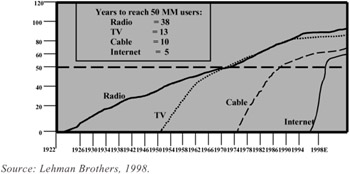Disruptive Technology
|
From Figure 4, we see that newer disruptive technologies are being adopted in shorter intervals. [14]

Figure 4: Technology Adoption Rates
Contrasting the adoption rate for the Internet seen in Figure 4, in Table 7, we see that wireless narrowband communications took significantly longer to reach 50 million users.
| Year | 1984 | 1986 | 1990 | 1994 | 1995 | 1996 | 1997 | 1998 | 1999 | 2000 | 2001 | 2002 |
| Subscribers | 0.085 | 0.265 | 5.3 | 24.2 | 33.8 | 44 | 55 | 69 | 86 | 109 | 127 | 144 |
| Sources: Statistical Abstract of the U.S., ITU, CTIA. | ||||||||||||
This lag in wireless narrowband adoption rates was principally due to the relatively high fees carriers charged end users, limiting this market to only business users for a significant period of time. However, from 1997 to 2001, after the introduction of the "Digital One Rate" plans, subscriber growth exploded from 55 million subscribers to over 120 million. This adoption rate for narrowband wireless should indicate to the carriers that the significant driver in this market might also pertain to the broadband wireless market. Clearly with computer and Internet usage growing as rapidly as it is, a properly priced mobile/portable wireless access medium would likely be appealing to many subscribers (see also Table 8).
| Category | 1990 | 1991 | 1992 | 1993 | 1994 | 1995 | 1996 | 1997 | 1998 | 1999 | 2000 | 2002 Est. |
|---|---|---|---|---|---|---|---|---|---|---|---|---|
| Main telephone lines (millions) | 520 | 546 | 574 | 606 | 645 | 692 | 740 | 794 | 848 | 906 | 970 | 1115 |
| Mobile wireless subscribers (millions) | 11 | 16 | 23 | 34 | 55 | 91 | 145 | 214 | 319 | 472 | 650 | 1000 |
| Personal computers (millions) | 120 | 130 | 150 | 170 | 190 | 230 | 260 | 320 | 370 | 430 | 500 | 670 |
| Internet users (millions) | 2.6 | 4.4 | 6.9 | 9.4 | 16 | 34 | 54 | 90 | 149 | 230 | 311 | 500 |
| Source: International Telecommunications Union, 2000 (www.itu.org). | ||||||||||||
[14]Christensen, C. (1997). The innovator's dilemma. Harvard Business School Press. This book provides excellent insight into the realm of disruptive technologies and demonstrates how they can quickly appear and capture entire markets. Note that the book is misnamed. It is actually not the innovator's dilemma, but everyone else's.
|
EAN: 2147483647
Pages: 139